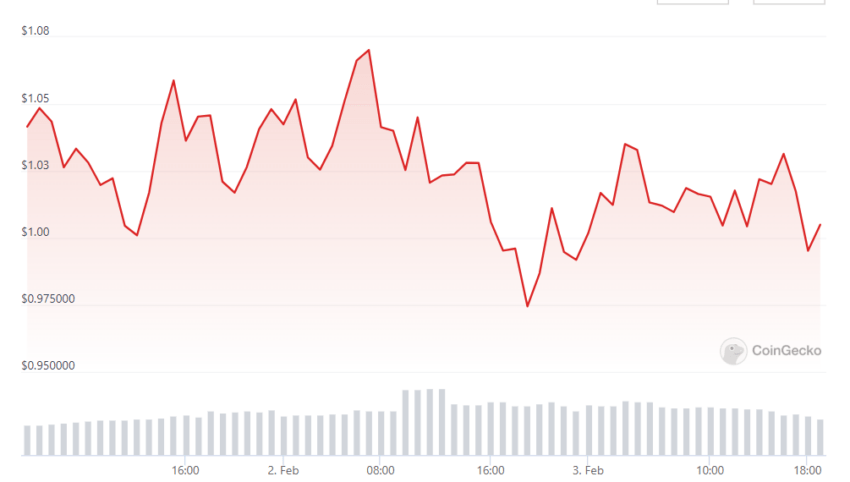Cardano DJED Depegging Reignites Stablecoin Backing Debate

Earlier this week, Cardano’s recently-launched stablecoin Djed lost its peg to the U.S. dollar, drawing attention to the importance of regulatory frameworks governing stablecoin reserves.
On Feb. 2, 2022, days after its ballyhooed release, Cardano’s “overcollateralized” Djed stablecoin briefly dipped below the $1 mark to around 97.5 cents. Stablecoins lose their $1 value when issuers do not hold sufficient liquid reserves to honor withdrawals.
Djed’s Overcollateralization Should Prevent Depegging
Stablecoins are digital assets that use fiat, other cryptocurrencies, or commodities to maintain a value of $1.
Coins like Djed try to avoid a bank run scenario during times of market stress by over-backing their coins with liquid assets. The circulating supply of Djed is currently worth $1.8 billion, backed by $12 billion worth of ADA.
Considering its over-collateralized nature, Djed’s brief dip could have been caused by a sharp drop in collateralization ratio, accompanied by insufficient liquidity from SHEN holders. This scenario allows redemptions but prevents additional minting until more collateral is added.

DJED/USD Hourly Price Chart | Source: CoinGecko
According to issuer COTI, Djed’s collateral must stay between four to eight times the amount of Djed minted. A user must send $1 of ADA to a smart contract address to receive one Djed. Users wishing to mint a reserve coin SHEN must send ADA to the same smart contract, adding to the overall ADA and increasing Djed’s collateralization ratio. SHEN holders cannot redeem their coins for ADA as long as Djed’s collateralization ratio is below 400%, nor can they mint more SHEN when the ratio reaches its maximum value.
Djed holders can redeem their coins for dollars by sending them back to the smart contract. The smart contract burns the Djed and issues $1 worth of ADA.
Layer-1 blockchain COTI and Cardano IOG recently launched Djed on the Cardano mainnet.
Last year Cardano founder Charles Hoskinson accused former FTX CEO Sam Bankman-Fried of attacking Cardano through the media. In a 2022 vlog, Cardano co-founder Hoskinson alleged that crypto news outlet The Block embarked on a Cardano smear campaign while Bankman-Fried’s Alameda Research extended loans to The Block’s former CEO Michael McCaffrey.
Regulatory Noose Tightens Around Reserve Requirements
Recent stablecoin blow-ups have increased regulatory scrutiny. Because stablecoin issuers are not regulated like banks, regulation surrounding minimum capital reserves is scant. Additionally, no accounting standards govern the scope of reserve audits. Centralized issuers Tether and Circle have instead committed to publishing attestation reports to provide a window into their reserve compositions.
Paxos Trust, issuer of the Pax dollar and the Binance-branded BUSD stablecoins, issues attestations after each month’s end detailing its reserves. Independent accounting firm WithumSmith+Brown, PC, compiles the reports. Tether recently reduced the portion of its reserves held in commercial paper for short-term government treasury bills.
Upcoming legislation by the European Union mandates auditable financial reserves held in banks for fiat-backed stablecoins. A proposed U.S. stablecoin bill by the House Financial Services Committee seeks to impose a moratorium on non-fiat-backed stablecoins pending the findings of a Treasury Department report.






 Bitcoin
Bitcoin  Ethereum
Ethereum  Tether
Tether  USDC
USDC  TRON
TRON  Dogecoin
Dogecoin  Cardano
Cardano  Bitcoin Cash
Bitcoin Cash  Chainlink
Chainlink  Monero
Monero  LEO Token
LEO Token  Zcash
Zcash  Stellar
Stellar  Litecoin
Litecoin  Hedera
Hedera  Dai
Dai  Cronos
Cronos  Tether Gold
Tether Gold  OKB
OKB  Ethereum Classic
Ethereum Classic  KuCoin
KuCoin  Gate
Gate  Algorand
Algorand  Cosmos Hub
Cosmos Hub  VeChain
VeChain  Tezos
Tezos  TrueUSD
TrueUSD  Dash
Dash  Stacks
Stacks  IOTA
IOTA  Decred
Decred  Basic Attention
Basic Attention  Theta Network
Theta Network  NEO
NEO  Synthetix
Synthetix  Qtum
Qtum  Ravencoin
Ravencoin  DigiByte
DigiByte  0x Protocol
0x Protocol  Nano
Nano  Zilliqa
Zilliqa  Holo
Holo  Siacoin
Siacoin  Numeraire
Numeraire  Waves
Waves  BUSD
BUSD  Status
Status  Enjin Coin
Enjin Coin  Pax Dollar
Pax Dollar  Ontology
Ontology  Lisk
Lisk  Hive
Hive  Steem
Steem  Huobi
Huobi  OMG Network
OMG Network  NEM
NEM  Bitcoin Gold
Bitcoin Gold  Augur
Augur  HUSD
HUSD